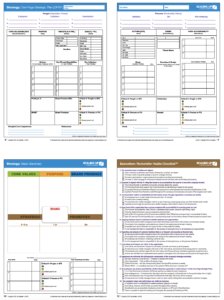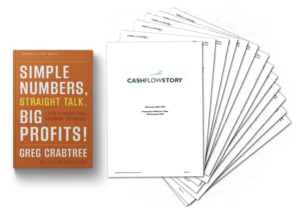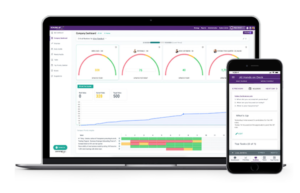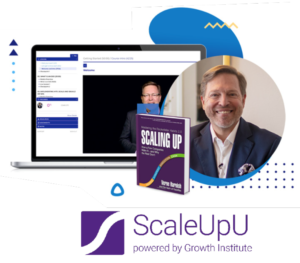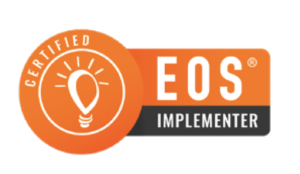Are you considering implementing Scaling Up or EOS in your business? Not sure which is right for you? This article gives a frank comparison of Scaling Up Vs EOS...
I just came across Traction by Gino Wickman and looked into his Entrepreneurial Operating System (EOS). It sounds a lot like Scaling Up: Rockefeller Habits 2.0. Is that a coincidence?
That isn’t surprising. Many people find the fundamentals of Traction oddly similar to Scaling Up: Mastering the Rockefeller Habits 2.0. 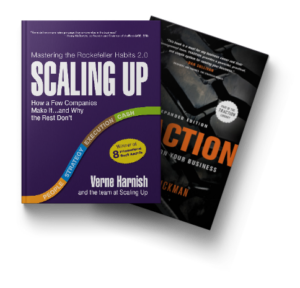
Both Scaling Up/Rockefeller Habits, and later EOS, grew out of the need to help leaders manage the chaos that comes with scaling up an organization. Though there’s plenty of information on how to start a business, and an equal number of MBA programs designed to help you manage a large company – there wasn’t a comprehensive “parenting manual” for how to scale up a small to mid-market business.
To address this gap, in 1991 I launched an executive education program, in partnership with MIT and Inc. Magazine, called “The Birthing of Giants.” Over the next decade the foundational ideas that became branded as the Rockefeller Habits were developed, tested, and continuously updated as the core curriculum for what is now called the Entrepreneurial Master’s Program (EMP), a program in which I still teach today. To date, over 1,800 leaders of growing firms have graduated from that EMP program and over 70,000 companies, worldwide, utilize Scaling Up (Rockefeller Habits 2.0).
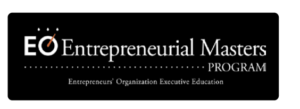
Scaling Up (Rockefeller Habits 2.0) continues to serve as a foundational framework for EO’s EMP held on the campus of MIT. The Scaling Up content, for the past decade, also serves as the core curriculum for EO’s Accelerator program, helping companies scale from a few hundred thousand dollars to beyond the minimum $1 million revenue threshold required to join EO.
 As for Gino, he was one of thousands of CEOs using the Rockefeller Habits tools and techniques – later detailed in my 2002 book Mastering the Rockefeller Habits – to scale and exit his own company. He later became one of our early coaching partners when we started the Scaling Up Certified coaching network (originally called Gazelles). He specifically represented and exclusively used the Rockefeller Habits to coach other companies on behalf of my firm – and was an outstanding coach for us.
As for Gino, he was one of thousands of CEOs using the Rockefeller Habits tools and techniques – later detailed in my 2002 book Mastering the Rockefeller Habits – to scale and exit his own company. He later became one of our early coaching partners when we started the Scaling Up Certified coaching network (originally called Gazelles). He specifically represented and exclusively used the Rockefeller Habits to coach other companies on behalf of my firm – and was an outstanding coach for us.
As is often the case among entrepreneurs, Gino eventually chose to leave and create a modified system of his own. Five years after Mastering the Rockefeller Habits was published, he wrote Traction, crediting many of its ideas to what he learned implementing the Rockefeller Habits in his own firm and others.
What are the Similarities Between Scaling Up and EOS?
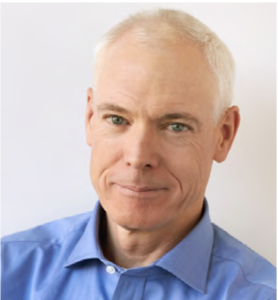 Scaling Up and EOS share a few similarities in their approach to helping scaleups.
Scaling Up and EOS share a few similarities in their approach to helping scaleups.
They are each designed to help you get your team aligned around a shared vision, as Jim Collins recommends. Each includes structured monthly, quarterly and annual sessions to help you execute their respective tools. Both focus on helping you achieve your objectives, and both offer coaching and software to help you scale.
How Are EOS and Scaling Up Different?
Scaling Up offers what we brand a “performance platform.” EOS, as the name implies, offers up an “operating system.” Though both are related, as noted above, the scalability and scope of each differ significantly.
In short, operating systems are a “last century” term that gained popularity in the 1990s as personal computers became more prevalent —think of the early disk operating system (DOS). This century, modern firms prefer to use broader platforms that allow leaders like yourself to layer on capabilities as needed and that integrate seamlessly.
It’s also why some of the fastest growing companies are creating platform technologies vs. simplistic operating systems for entire industries. The “Scaling Up Performance Platform” provides this same capability for leaders of scaleups.
Scaling Up and Traction, as books, are also quite different. Scaling Up integrates (and acknowledges) ideas and tools from forty other thought leaders and their books and best practices. Traction is singular in its approach and based, essentially, on the ideas of one person. Here are some of the major differences:
1. Scope and Scale | Scaling Up Vs EOS
EOS is a one-size-fits all, plug-and-play system with a fixed beginning, middle, and end–and is helpful for smaller firms in the beginning stages of installing the original three foundational habits from the Rockefeller Habits: setting priorities, establishing metrics, and implementing various meeting rhythms (except the daily huddle – more on that below). EOS also has its own version of the original One-Page Strategic Plan (OPSP) from Rockefeller Habits. The average client uses EOS for 18-24 months, according to the 2 Year EOS Overview.
Scaling Up is more comprehensive and open-ended, remaining adaptable to the immediate needs and constraints of the business. As a result, Scaling Up has continued to produce new tools/models/best practices to evolve with the ever-changing growth environment. Scaling Up is generally geared for larger firms (25 – 2500 employees) and younger firms/startups wanting to scale more rapidly. Additionally, Scaling up helps a firm install the same foundational Rockefeller Habits and utilizes the original One-Page Strategic Plan and updated one-page Vision Summary. The average client uses Scaling Up for the duration of their business through exit–and will bring the platform over to the acquirer, if they stay on. This is how many divisions of Fortune 500 firms have come to use Scaling Up.
2. Strategy | Scaling Up Vs EOS
EOS centers on the “Six Key Components of Every Business:” People, Vision, Data, Process, Issues and Traction. Scaling Up centers on the “Four Decisions” (the 4Ds) every organization must get right in order to scale: People, Strategy, Execution and Cash.
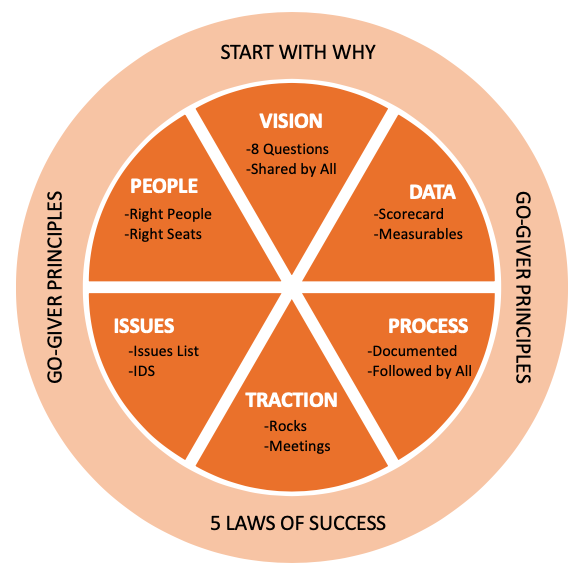
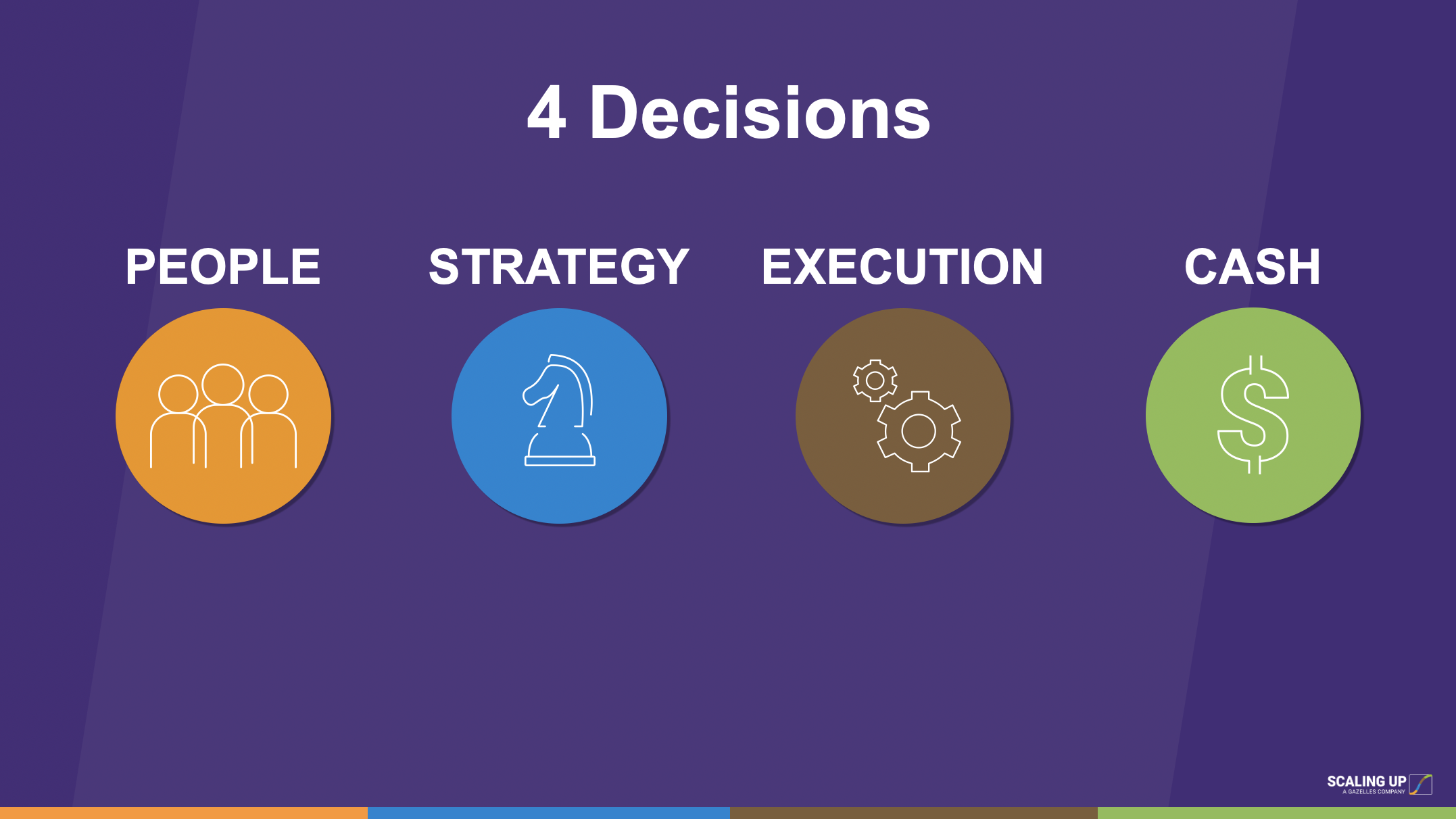
A key difference revolves around getting a company’s strategy right. As one blogger put it, “EOS 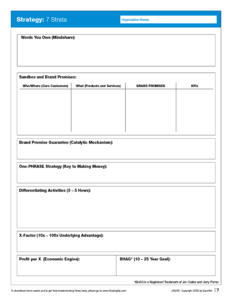
Scaling Up integrates the top strategy thought leaders (mainly from Harvard Business School) into a one-page tool called the “7 Strata”— seven decisions a company must get right if it’s to dominate its market, reduce marketing costs, and generate outsized margins (generally 3x–5x industry average profitability).
3. Cash | Scaling Up Vs EOS
A company can get by with decent people, decent strategy, and decent execution – but not a day without cash. EOS, as indicated by its framework, doesn’t have a rich set of tools or technology platforms to help leaders make important decisions on how to scale through internally generated cash.
Scaling Up teaches the ever important principles of the CCC (cash conversion cycle), which is the technical term for how long it takes, after you spend a dollar/euro/yen on rent, utilities, payroll, inventory, marketing, etc. for it to make its way through your business model and back into your pocket.
Scaling Up integrates Greg Crabtree’s Simple Numbers and Alan Miltz’s Cash Flow Story tools and technology into its performance platform, giving leaders a comprehensive understanding of how cash flows through the business. The Scaling Up “Power of One” tool and technology platform allows scaleups to perform quick “what-if?” scenarios to see the impact on cash and profit. And the Scaling Up Certified coaching partners provide a quarterly cash-flow analysis to make sure the firm isn’t “growing broke” as it scales.
4. Daily Huddle | Scaling Up Vs EOS
EOS, while replicating many of the Rockefeller Habits, de-emphasizes the need for the daily huddle–making EOS much more appealing, on the surface, to clients unfamiliar with this critical routine.
Scaling Up emphasizes the importance of a daily huddle, a short meeting designed to get quick input from your team and keep everyone aligned. Properly implementing the daily huddle saves hours of frustration, as well as time wasted emailing back and forth. Teams find, for instance, that every minute they participate in a daily huddle gives them back 10 minutes in their schedule. Thus, an 8-minute daily huddle will win everyone back about an hour-and-a-half a day.
Our coaching partners spend the necessary time to support teams in implementing the daily huddle. Executed properly, the daily huddle eliminates the “administrivia” that clogs up the weekly meeting, allowing it to be more strategic. And, though startups sometimes resist implementing the daily huddle; once they get into the rhythm of this crucial habit—a fundamental dating back to John D. Rockefeller and used by the late Steve Jobs and almost every technology firm using agile to scale their platforms–it’s a game-changer. If you want to scale faster, you need to pulse faster.

Although EOS promises to be easier and less time consuming initially to implement (its reason for de-emphasizing the daily huddle), in the long run you will leave a lot of money and time on the table. As Albert Einstein put it, “Everything should be made as simple as possible but not simpler.”
5. Technology Platform | Scaling Up Vs EOS
The Scaling Up Scoreboard is a comprehensive and mobile-ready SaaS platform used by thousands which integrates seamlessly with the Scaling Up Performance Platform and tools. Using the Scaling Up Scoreboard enables you to store planning, execution and communication activities in one centralized tool, with cascading responsibilities and accountabilities shared across the full team. All the Scaling Up growth tools, including the One-Page Strategic Plan, are a part of the Scoreboard platform. The Scaling Up Scoreboard also includes mobile-ready visual dashboards that keep you on track with real-time progress updates on your priorities, critical numbers and KPIs.
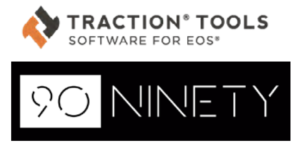
6. Professional development | Scaling Up Vs EOS
Scaling Up, through ScaleUpU, offers leaders and their employees’ access to online accredited executive education programs–an outsourced corporate university for small to mid-market firms (several Fortune 500 firms also utilize these courses). Leaders can enroll in our accredited Master of Business Dynamics (MBD) program, which offers an entire suite of branded and professionally coached master courses around growth, sales, marketing, leadership, execution, HR, and cash management. There is also a Master Course specifically geared to implementing Scaling Up. These blended online programs have a 78% graduation rate among executives. (MOOCs, in contrast, have a dropout rate above 90%).
EOS has an online training program called EOS Basecamp, focused only on implementing EOS’s operating system.It offers training videos on how to use 20 downloadable tools, along with printable worksheets and guides. In addition, Gino Wickman and Rene Boer’s book How to be a Great Boss is part of the EOS library.
7. Coaching | Scaling Up Vs EOS
Both EOS and Scaling Up rely on coaching partners to support implementation of their respective approaches. Each differs in the initial and ongoing training and development provided these coaching partners.
EOS offers initial training to its implementers but does not require them to participate in ongoing education to maintain certification. EOS Implementers spend 2.5 days at the beginning of their journey learning how to give the introductory workshop. Its “Certified Implementers” must attend three out of four Quarterly Collaborative Exchanges, which are one-day sessions with their peers. “Professional Implementers” are required to attend just two of the four. Much of the training they get is on-the-job. EOS will often encourage executives within their client base to become internal implementers and then actively recruit them to leave the client and become full time implementers for EOS.
 Scaling Up Certified coaching partners, located on six continents, spend a similar 2.5 days of initial education – and must participate in a minimum of 48 hours of continuing education every year to remain certified (some take part in upwards of 250 hours) – similar to the number of hours required by doctors to keep their license. Besides keeping current on the ever-evolving Scaling Up performance platform, Scaling Up Certified coaches are exposed each year to dozens of other thoughts leaders, helping them to remain up-to-date on the new ideas/tools as methods for scaling–sales, marketing, strategy, execution, and cash. They also have access to a wide range of complementary tools, techniques and advanced certifications that allow them to customize the performance platform to the needs of an organization, once they assess a company according to where it stands on the 4Ds. EOS Implementers are restricted from using any additional methodologies besides EOS.
Scaling Up Certified coaching partners, located on six continents, spend a similar 2.5 days of initial education – and must participate in a minimum of 48 hours of continuing education every year to remain certified (some take part in upwards of 250 hours) – similar to the number of hours required by doctors to keep their license. Besides keeping current on the ever-evolving Scaling Up performance platform, Scaling Up Certified coaches are exposed each year to dozens of other thoughts leaders, helping them to remain up-to-date on the new ideas/tools as methods for scaling–sales, marketing, strategy, execution, and cash. They also have access to a wide range of complementary tools, techniques and advanced certifications that allow them to customize the performance platform to the needs of an organization, once they assess a company according to where it stands on the 4Ds. EOS Implementers are restricted from using any additional methodologies besides EOS.
8. The Cost of Implementing EOS Vs Scaling Up
Implementing EOS will cost you from $14 (for the paperback version of Traction) to $50,000+ per year.
Installing Scaling Up will cost you from $20 (for the paperback version of the Scaling Up) to $40,000 – $200,000+ per year for full coaching support. For more detail on the costs for installing Scaling Up see the article “How Much Does Scaling Up (Rockefeller Habits 2.0) Cost to Implement?”.
One reason for the difference in pricing is the amount of time spent with clients. Some Scaling Up coaches meet with CEOs and their teams monthly; facilitate two-day quarterly sessions; and lead two to three-day annual planning sessions. Weekly calls, if needed to fine tune daily and weekly huddles, are also included in many coaching packages. In total, this is 10 to 25 days of facilitation and support.
A typical fixed EOS engagement starts with one monthly session in the first sixty days; thereafter, the meetings are one-day quarterly sessions, with one two-day annual session. There are no in-person sessions in between. Some coaches check in by email or schedule a phone call prior to the session. This amounts to 5-6 days of coaching time per year.
Scaling Up Vs EOS?
Still not sure? We’re happy to help with initial complimentary 4D and Cash Flow assessments. We’ll discuss where you are and where you want to go as a business, and then we’ll readily share which options we feel are an ideal fit for you and your business. Contact us at coaching@scalingup.com.
